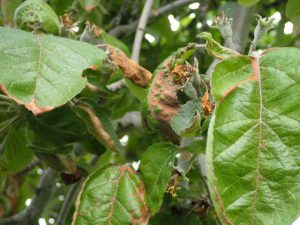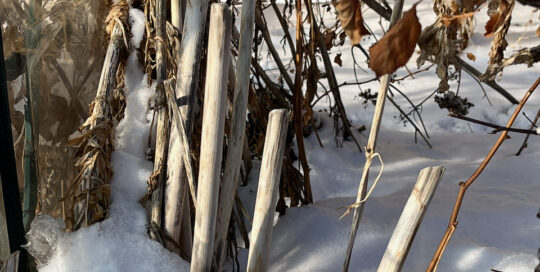Why are the Apple Tree’s Leaves Turning Brown?
Views: 20555

It seems as if half of the time spent in the yard or garden is trying to solve a mystery of some sort. The latest is what is making the leaves on some of the apple trees turn brown around the edges. And, what’s truly puzzling, is we aren’t the only ones with the issue. A friend on the other side of the mountains has the same problem on one of his trees where a few of the branches have leaves that are turning brown along the edges.
One of the first steps in figuring out what it is, is determining what it isn’t. After a few years of brutal, first-hand education, I can safely say it is not fire blight. With a blighted tree, the leaves wither and die and sometimes look black. These are just a little brown on the edges.
An initial thought was its a cedar apple rust, but it typically manifests by round, yellowish spots on the leaves. It’s the same with apple scab, the next possible culprit. It produces galls instead of brown leaves. Even though we can’t pinpoint a specific fungus, my husband sprayed them with a fungicide in the off-chance it is an unknown issue caused by our wet spring.
But, since we’re not convinced it is a fungus, I wonder if more indications point towards a general health issue. We can cross off drought concerns for both our trees and our friend’s orchard. We’ve had ample rain this spring. And while too much water can cause similar issue, the precipitation we receive is nothing compared to other parts of the country.
Nutrient Deficiency
A nutrient deficiency, particularly potassium or magnesium, can also cause the leaves to discolor. Potassium is critical to tree vigor and growth, and the formation of apples is known to pull a tremendous amount of this nutrient from the tree. One of the symptoms is browning leaves, although this typically happens later in the season. Even so, a lack of potassium is my leader in what might be happening.
Magnesium deficiencies typically shows up as a yellowing of the leaves, instead of making them turn brown and crisp. And, what I found particularly interesting when I was researching what could be happening, is a lack of sufficient zinc causes “blind spots” in the branches where the leaves may not unfurl completely. We had that on a couple of the apple trees this year making we wonder if we have an overall nutritional issue. I think the best course of action is to add a balanced fertilizer to each of the trees, as well as finding a foliar spray for zinc since I’ve learned that a ground application of zinc in alkaline soils usually doesn’t do much good. The higher pH affects how the tree utilizes some nutrients.
In the search for what might be ailing the trees, insects also become possible culprits. Caterpillars and aphids can damage, but they are usually more erratic or obvious of insect feeding patterns with either holes or linear damage.
So the mystery of the browning apple leaves continues. We’ll see if the fungicide does anything to help them, and I am going to fertilize at least a couple of the trees to see if that makes a difference. Once we figure out what’s going on, I’ll be sure to share it with you!
Meet Amy Grisak
Amy is a freelance author and photographer in Great Falls, MT who specializes in gardening, foods, and sustainable agriculture. She provides information on every kind…
Amy's Recent Posts

This Little Piggy is a Problem: Dealing with Feral Hogs








